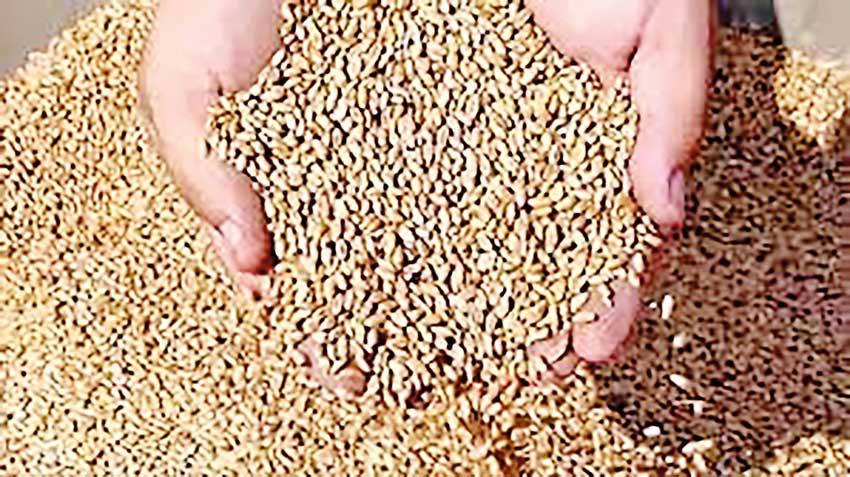Reply To:
Name - Reply Comment

 Today, three decades later, those who made a living out of vilifying rice and promoting wheat seem to have realized that rice is a hard habit to kick. It’s not all bad news for the businesses that benefited from the kind of policy-regime that ‘experts’ wanted to establish. Today, three decades later, those who made a living out of vilifying rice and promoting wheat seem to have realized that rice is a hard habit to kick. It’s not all bad news for the businesses that benefited from the kind of policy-regime that ‘experts’ wanted to establish. |
 When the then US Ambassador to Sri Lanka and the Maldives, Teresita Currie Schaffer, insisted in the early 1990s that Sri Lanka’s food security lies in the wheat fields of North America, it was obviously a part of a general anti-rice rant with a view to propping the American wheat farmer. This is not surprising for Schaffer had served in the State Department as Director of the Office of the Office of International Trade in the early 1980s.
When the then US Ambassador to Sri Lanka and the Maldives, Teresita Currie Schaffer, insisted in the early 1990s that Sri Lanka’s food security lies in the wheat fields of North America, it was obviously a part of a general anti-rice rant with a view to propping the American wheat farmer. This is not surprising for Schaffer had served in the State Department as Director of the Office of the Office of International Trade in the early 1980s.
It made sense as per certain dubious economic theories: you can grow or you can buy, so if you have purchasing power, it doesn’t matter whether or not you grow whatever it is you may want to eat. Just imagine if the Russia-Ukraine crisis had happened in a context where few if any Sri Lankans were bread-dependent!
The 1990s was full of that kind of rhetoric which of course was dutifully regurgitated by some politicians, academics and officials. It was complemented with a lot of anti-rice ‘expert’ opinions. Some pointed out that the world needs to get out of rice because the crop emitted greenhouse gases. They didn’t say that the world’s biggest industrial polluters, including the USA, should shut down factories. Some said ‘wheat tastes better.’
Absent in the entire discourse was the issue of health. What was recommended was wheat bread; rice was rubbished. Well, not exactly the hybrid varieties that made the big boys and girls of the seed industry and those in the agrochemical business very, very rich.
Privatization of water resources in the guise of democratizing management a la user-control was another attempt to wrest control of water and thereby what could be cultivated. The question is one of food sovereignty but that’s not enough either. It’s nutritional sovereignty that counts.
Today, three decades later, those who made a living out of vilifying rice and promoting wheat seem to have realized that rice is a hard habit to kick. It’s not all bad news for the businesses that benefited from the kind of policy-regime that ‘experts’ wanted to establish. The seed industry will continue to thrive. The chemical fertilizer industry will continue to thrive. The agrochemical producers will continue to thrive. Those who benefit from recommending policies that necessitate such inputs will probably continue to reap benefits in terms of luxury holidays and kick-backs. The paddlers who have for all intents and purposes play the role of agriculture extension officers will continue to thrive. Meanwhile Sri Lankans will continue to be exposed to all manner of health risks including non-communicable diseases such as diabetes.
And now, they have come up with a new strategy, again wrapped in the rhetoric of good intention - fortified rice. The argument is quite simple and could be persuasive: if Sri Lankans cannot kick the rice habit and if rice is not contributing to nutritional sovereignty, let’s do fortified rice!
What are these ‘fortified rice’ varieties? What kind of hybrids are they and who develops them? In other words, who will grow and sell the seeds? Are they the kinds of seeds that need to be purchased every year or can farmers, farming collectives and nations create their own seed banks? Will they need pesticides and weedicides and if so, who produces the same? Or are we to imagine that no one is interested in profits and that economic benefits have not played any role whatsoever in designing these proposals?
So, there are issues. There’s national security. There’s national food security. There’s national food sovereignty. There’s national nutritional sovereignty. There are also issues about the dangers typical of single-option solutions. What’s required, experts critiquing India’s fortification strategy claim, is to look for balance.
So, let’s talk about balance then. What is important is to see rice as one of many foods that make for a good, nutritious meal. In such a situation, rice works as a staple best when it is complemented by fruits, vegetables, yams etc., that make for ‘balance.’ For this, we need to know what’s out there, what is grown, what grows wild and recover memory of all this.
Even as of now, Sri Lanka lacks a comprehensive food inventory or, more accurately, a comprehensive mapping of available foods. The focus has been on commercially grown foods. Now had the ‘experts’ thought about such things, then volume wouldn’t be larger-than-life, volume would not be the be all and end all of policy-making. Complementarity would have been accorded some value. Nutrition would have been factored in. Medicinal properties too.
Back to rice. There are 300 traditional rice varieties stored in Gannoruwa, apparently. The number of varieties ‘gifted’ to the International Rice Research Institute is probably greater. IRRI has over 11,000 rice varieties. Today, traditional rice varieties are grown only in small quantities by a small number of farmers who have, despite many challenges, operated as the guardians of these seeds and the knowledge associated with them. Here’s a fact that should open eyes: the nutritional density of traditional rice varieties is far superior to that of the high-yielding varieties that have been made to become more popular.
But yes, there is a concern about volume as in how much per hectare. The problem is that the moment nutrition is thrown out of the equation, we are left with only volume. That’s bad science which is probably good for certain kinds of businesses.
There are eight universities with agriculture or agriculture-related faculties. Each faculty probably has over 1,000 students. In addition, almost all universities have departments covering subjects such as economics, sociology, geography, statistics, plant science etc. Even if just 1% of students were persuaded to study traditional rice varieties, map food complement of villages, assess nutritional densities etc., we are talking about a corpus of knowledge hitherto absent in policy-making.
That, ladies and gentlemen, would be ‘fortification’ of the kind that multilateral agencies and ‘experts’ drafting policy briefs for politicians would never want to see the light of day. So, we want food sovereignty on the table. We want nutritional sovereignty on the table. We want science to be informed by a full consideration of all relevant factors and a concerted effort to obtain such information. Any ‘fortification’ proposal that tries to transplant theories that shy away from such an exercise has to be read as mischievous. And any politician or official saluting such recommendations be seen as an enemy of the people.
[email protected]. www.malindawords.blogspot.com